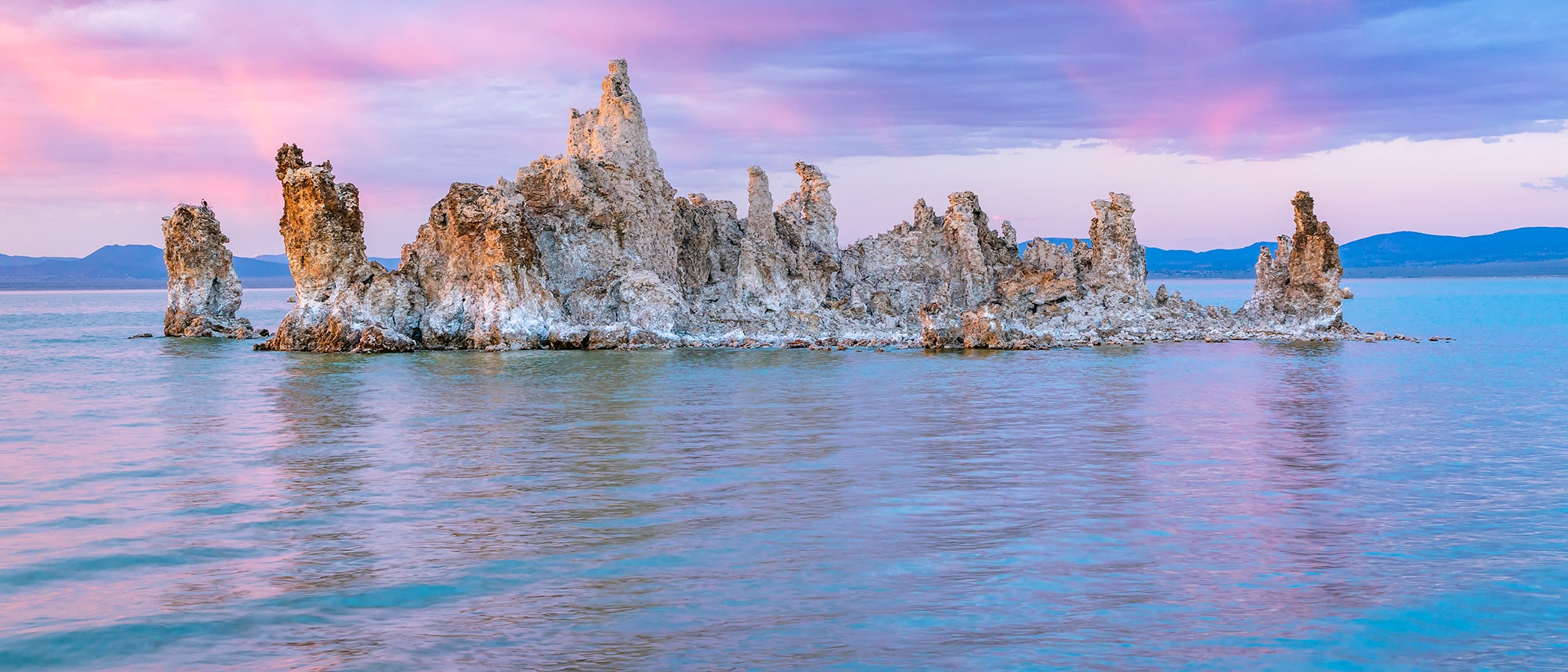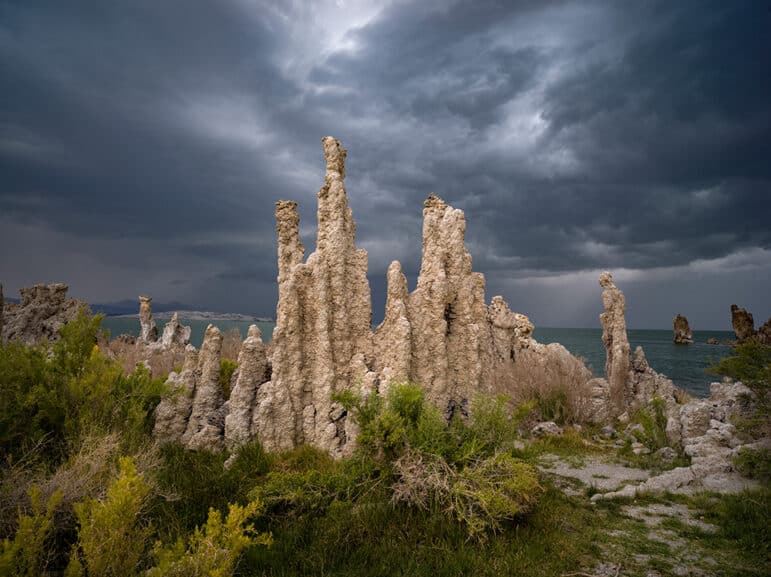
This essay, written by Stephen Trimble, appears in the 2024 Mono Lake Calendar.
The great Western writer Wallace Stegner knew that “the Great Basin is a unifying force; wherever you live in it, you flow toward every other part.”
And as you flow across this vast sanctuary of aridity, lakes and marshes capture you. Every runoff-collecting sink—even the ones gone dry—adds syncopation to the 2/4 time signature of the Basin and Range roller coaster (basin, range; basin, range). A vibrant moment of relief, of respite. Of marsh life, of wheeling gull and spinning phalarope. A beat, simply, of water in this arid world.
Visitors often describe the stillness and quiet here as timeless. But deserts are dynamic and their saline lakes fragile, none more so than the two salty pools landmarking the western and eastern rims of the Great Basin, Mono Lake at the base of the Sierra Nevada and Great Salt Lake at the base of Utah’s Wasatch Mountains.
These delicate, surprising islands of eco-vitality in the gray-green sagebrush sea survive as fragments of the great lakes that transformed our desert basins in the Pleistocene.
In that changeable past, Mono’s beaches with their Seussian tufa columns lay under 800 feet of water. This ancient version of Mono Lake overflowed into Owens Valley and beyond to Death Valley. Icebergs floated across its surface. Mammoths and sloths came to the lake to drink. Short-faced bears and dire wolves lay in wait for them.
And then waves of humans came here to live, as the climate kept warming, cooling, warming again. The big Pleistocene mammals disappeared; our familiar landscape evolved. The lake stabilized. And a newly urban civilization tapped Mono’s water for faraway cities, adding pipes and valves to natural drainages, taking control.
We now live in a new geologic era defined by these human impacts: the “Anthropocene.” Eight billion of us have accelerating power to shape our planet. We scatter our industrialized traces in the rocks. We burn fossil carbon from plants that grew 300 million years ago and tap out aquifers for their ancient water. We blithely divert streams to fields and cities, never mind the consequences.
In the 20th century, we reveled in the Big Build-Up in the American West. Aqueducts and dams, power plants and mines, highways and housing. Now, our 21st century task must be problem-solving, reckoning with our hubris, cleaning up the messes we created during the last century.
In 1989, when I published my Great Basin natural history book, The Sagebrush Ocean, Intermountain Westerners had just luxuriated in the wettest decade in the 20th century. Great Salt Lake hit its historic high in 1987 when rising waters threatened the Salt Lake City Airport. Mono Lake bumped upward from its frightful 1981 low of 6372 feet when the lake held just half its prediversion volume.
Were we heading into a cozy holiday feast of abundant water, enough for both thirsty Angelenos and withering desert lakes? Alas, the weather normalized, the climate continued to warm. Diversions continued. Both lakes began to decline once again.
And then Mono Lake activists created what looked like a miraculous reprieve.
To catch Mono Lake in its tumble toward collapse, the Mono Lake Committee led legal battles that triumphed in 1994. The California State Water Resources Control Board mandated a healthy lake elevation of 6392 feet—midway between pre-diversion highs and post-diversion lows. California Gulls nesting on Negit Island would be safe from predators. Salinity would stay within the range needed for alkali flies and brine shrimp to reproduce by the gazillion. The ecosystem would thrive.
Los Angeles backed off on diversions. The lake began to rise. But the hydrologists projected wetter years than we’ve seen.
In 2023, nearly 30 years after the 1994 decision, the lake remained 12 feet shy of the desired “management level.” It’s a discouraging story but one we now understand: decreased precipitation, lower runoff from the Sierra, increased evaporation, continued diversions—all require adaptation. To live up to its mandate, the State Water Board must pause or limit diversions to bring Mono Lake—finally—to a baseline healthy level that can buffer the effects of climate change.
Crises bring awareness, and awareness can create change. We are paying more attention to our dynamic desert lakes. Congress enacted a 2022 law to “assess, monitor, and conserve” the imperiled saline lake ecosystems in the Great Basin, a welcome first for coordinated regional planning.
Each of the dozens of basins in the greater basin faces the same facts: water comes in, evaporates, concentrates salts, and has no drainage to the sea. They also face the same challenges. Divert inflow and a lake declines. Warm the climate and a lake declines.
Twin symbols of Great Basin wetlands, Mono Lake and Great Salt Lake share these trials. They also benefit from notoriety, from massive volume, from passionate activism.
Great Salt Lake has been falling since those boom-water years forty years ago. This shallow saucer of brine has a maximum depth of just 33 feet, so every one-foot drop in lake level creates vast expanses of exposed lakebed, poised to blow away in clouds of toxic dust. The lake hit its historic low in 2022, and not even a record spring snowfall in 2023 can save it.
Five hundred miles away, Mono Lake’s protectors plea for the State Water Board to honor its commitment, to bring the lake to the healthy level mandated by law. The Native Northern Paiute people of Mono Lake, the Kootzaduka’a, appeal to Congress for federal Tribal recognition. The Los Angeles Department of Water and Power longs to keep the spigot open, pouring forth Sierra Nevada water from Mono Lake tributaries for their customers.
While humans debate the lake’s future, the California Gulls keep returning. Clouds shape-shift, mirroring the line-dance of tufa towers parading along the shore. Storms blanket the Sierra, summer scorches the Great Basin, climate scientists watch annual temperatures creep up.
Somewhere in this Anthropocene tangle of life and change lies the new balance we seek as we find our way in the 21st century Great Basin.

Award-winning Utah writer and photographer Stephen Trimble last wrote the essay for the Mono Lake calendar in 1996. He’s revising and updating his classic book, The Sagebrush Ocean: A Natural History of the Great Basin, for a 35th anniversary edition, to be published in 2024.
Top photo, “Shipwreck Tufa,” courtesy of David J. Gubernick.
